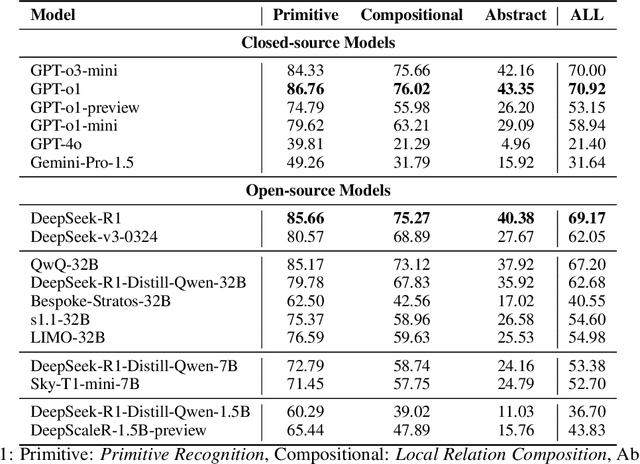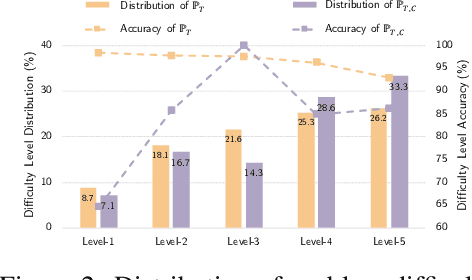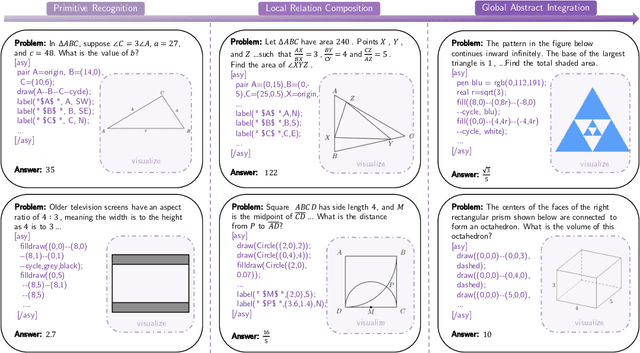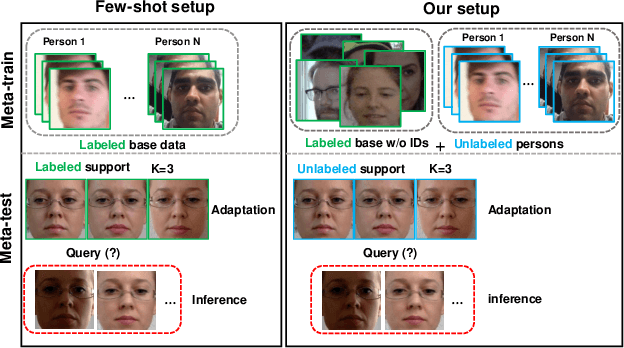Yong Wu
PEVLM: Parallel Encoding for Vision-Language Models
Jun 24, 2025



Abstract:Vision-Language Models (VLMs) have demonstrated strong performance in video-language tasks, yet their application to long video understanding remains constrained by the quadratic complexity of standard attention mechanisms. In this paper, we propose \textbf{PEVLM}, a parallel encoding strategy specifically designed to improve the prefill efficiency of VLMs without requiring model finetuning. PEVLM partitions the input into block-wise segments with a shared sink, preserves full-attention positional embeddings, and aligns attention weights to mimic full-attention distributions. This design reduces attention computation from $O((T \times N)^2)$ to $O(T \times N)$ while maintaining high accuracy. Extensive experiments on the LongVideoBench benchmark show that PEVLM achieves up to 8.37\% accuracy improvement over existing inference-efficient methods and delivers up to 7.47x speedup in attention computation and 40\% reduction in end-to-end latency. Under strict latency constraints, PEVLM significantly outperforms baselines, raising accuracy from 23.26\% to 61.03\%. These results highlight PEVLM's effectiveness for low-latency, long-context video understanding, making it well-suited for real-world applications such as autonomous driving.
Beyond Templates: Dynamic Adaptation of Reasoning Demonstrations via Feasibility-Aware Exploration
May 27, 2025Abstract:Large language models (LLMs) have shown remarkable reasoning capabilities, yet aligning such abilities to small language models (SLMs) remains a challenge due to distributional mismatches and limited model capacity. Existing reasoning datasets, typically designed for powerful LLMs, often lead to degraded performance when directly applied to weaker models. In this work, we introduce Dynamic Adaptation of Reasoning Trajectories (DART), a novel data adaptation framework that bridges the capability gap between expert reasoning trajectories and diverse SLMs. Instead of uniformly imitating expert steps, DART employs a selective imitation strategy guided by step-wise adaptability estimation via solution simulation. When expert steps surpass the student's capacity -- signaled by an Imitation Gap -- the student autonomously explores alternative reasoning paths, constrained by outcome consistency. We validate DART across multiple reasoning benchmarks and model scales, demonstrating that it significantly improves generalization and data efficiency over static fine-tuning. Our method enhances supervision quality by aligning training signals with the student's reasoning capabilities, offering a scalable solution for reasoning alignment in resource-constrained models.
GeoGramBench: Benchmarking the Geometric Program Reasoning in Modern LLMs
May 23, 2025



Abstract:Geometric spatial reasoning forms the foundation of many applications in artificial intelligence, yet the ability of large language models (LLMs) to operate over geometric spatial information expressed in procedural code remains underexplored. In this paper, we address this gap by formalizing the Program-to-Geometry task, which challenges models to translate programmatic drawing code into accurate and abstract geometric reasoning. To evaluate this capability, we present GeoGramBench, a benchmark of 500 carefully refined problems organized by a tailored three-level taxonomy that considers geometric complexity rather than traditional mathematical reasoning complexity. Our comprehensive evaluation of 17 frontier LLMs reveals consistent and pronounced deficiencies: even the most advanced models achieve less than 50% accuracy at the highest abstraction level. These results highlight the unique challenges posed by program-driven spatial reasoning and establish GeoGramBench as a valuable resource for advancing research in symbolic-to-spatial geometric reasoning. Project page: https://github.com/LiAuto-DSR/GeoGramBench.
Cognitive Memory in Large Language Models
Apr 03, 2025Abstract:This paper examines memory mechanisms in Large Language Models (LLMs), emphasizing their importance for context-rich responses, reduced hallucinations, and improved efficiency. It categorizes memory into sensory, short-term, and long-term, with sensory memory corresponding to input prompts, short-term memory processing immediate context, and long-term memory implemented via external databases or structures. The text-based memory section covers acquisition (selection and summarization), management (updating, accessing, storing, and resolving conflicts), and utilization (full-text search, SQL queries, semantic search). The KV cache-based memory section discusses selection methods (regularity-based summarization, score-based approaches, special token embeddings) and compression techniques (low-rank compression, KV merging, multimodal compression), along with management strategies like offloading and shared attention mechanisms. Parameter-based memory methods (LoRA, TTT, MoE) transform memories into model parameters to enhance efficiency, while hidden-state-based memory approaches (chunk mechanisms, recurrent transformers, Mamba model) improve long-text processing by combining RNN hidden states with current methods. Overall, the paper offers a comprehensive analysis of LLM memory mechanisms, highlighting their significance and future research directions.
Balanced 3DGS: Gaussian-wise Parallelism Rendering with Fine-Grained Tiling
Dec 23, 2024



Abstract:3D Gaussian Splatting (3DGS) is increasingly attracting attention in both academia and industry owing to its superior visual quality and rendering speed. However, training a 3DGS model remains a time-intensive task, especially in load imbalance scenarios where workload diversity among pixels and Gaussian spheres causes poor renderCUDA kernel performance. We introduce Balanced 3DGS, a Gaussian-wise parallelism rendering with fine-grained tiling approach in 3DGS training process, perfectly solving load-imbalance issues. First, we innovatively introduce the inter-block dynamic workload distribution technique to map workloads to Streaming Multiprocessor(SM) resources within a single GPU dynamically, which constitutes the foundation of load balancing. Second, we are the first to propose the Gaussian-wise parallel rendering technique to significantly reduce workload divergence inside a warp, which serves as a critical component in addressing load imbalance. Based on the above two methods, we further creatively put forward the fine-grained combined load balancing technique to uniformly distribute workload across all SMs, which boosts the forward renderCUDA kernel performance by up to 7.52x. Besides, we present a self-adaptive render kernel selection strategy during the 3DGS training process based on different load-balance situations, which effectively improves training efficiency.
ELF-UA: Efficient Label-Free User Adaptation in Gaze Estimation
Jun 13, 2024



Abstract:We consider the problem of user-adaptive 3D gaze estimation. The performance of person-independent gaze estimation is limited due to interpersonal anatomical differences. Our goal is to provide a personalized gaze estimation model specifically adapted to a target user. Previous work on user-adaptive gaze estimation requires some labeled images of the target person data to fine-tune the model at test time. However, this can be unrealistic in real-world applications, since it is cumbersome for an end-user to provide labeled images. In addition, previous work requires the training data to have both gaze labels and person IDs. This data requirement makes it infeasible to use some of the available data. To tackle these challenges, this paper proposes a new problem called efficient label-free user adaptation in gaze estimation. Our model only needs a few unlabeled images of a target user for the model adaptation. During offline training, we have some labeled source data without person IDs and some unlabeled person-specific data. Our proposed method uses a meta-learning approach to learn how to adapt to a new user with only a few unlabeled images. Our key technical innovation is to use a generalization bound from domain adaptation to define the loss function in meta-learning, so that our method can effectively make use of both the labeled source data and the unlabeled person-specific data during training. Extensive experiments validate the effectiveness of our method on several challenging benchmarks.
NTIRE 2024 Challenge on Short-form UGC Video Quality Assessment: Methods and Results
Apr 17, 2024



Abstract:This paper reviews the NTIRE 2024 Challenge on Shortform UGC Video Quality Assessment (S-UGC VQA), where various excellent solutions are submitted and evaluated on the collected dataset KVQ from popular short-form video platform, i.e., Kuaishou/Kwai Platform. The KVQ database is divided into three parts, including 2926 videos for training, 420 videos for validation, and 854 videos for testing. The purpose is to build new benchmarks and advance the development of S-UGC VQA. The competition had 200 participants and 13 teams submitted valid solutions for the final testing phase. The proposed solutions achieved state-of-the-art performances for S-UGC VQA. The project can be found at https://github.com/lixinustc/KVQChallenge-CVPR-NTIRE2024.
MAP: MAsk-Pruning for Source-Free Model Intellectual Property Protection
Mar 07, 2024Abstract:Deep learning has achieved remarkable progress in various applications, heightening the importance of safeguarding the intellectual property (IP) of well-trained models. It entails not only authorizing usage but also ensuring the deployment of models in authorized data domains, i.e., making models exclusive to certain target domains. Previous methods necessitate concurrent access to source training data and target unauthorized data when performing IP protection, making them risky and inefficient for decentralized private data. In this paper, we target a practical setting where only a well-trained source model is available and investigate how we can realize IP protection. To achieve this, we propose a novel MAsk Pruning (MAP) framework. MAP stems from an intuitive hypothesis, i.e., there are target-related parameters in a well-trained model, locating and pruning them is the key to IP protection. Technically, MAP freezes the source model and learns a target-specific binary mask to prevent unauthorized data usage while minimizing performance degradation on authorized data. Moreover, we introduce a new metric aimed at achieving a better balance between source and target performance degradation. To verify the effectiveness and versatility, we have evaluated MAP in a variety of scenarios, including vanilla source-available, practical source-free, and challenging data-free. Extensive experiments indicate that MAP yields new state-of-the-art performance.
Identifying the Defective: Detecting Damaged Grains for Cereal Appearance Inspection
Nov 20, 2023Abstract:Cereal grain plays a crucial role in the human diet as a major source of essential nutrients. Grain Appearance Inspection (GAI) serves as an essential process to determine grain quality and facilitate grain circulation and processing. However, GAI is routinely performed manually by inspectors with cumbersome procedures, which poses a significant bottleneck in smart agriculture. In this paper, we endeavor to develop an automated GAI system:AI4GrainInsp. By analyzing the distinctive characteristics of grain kernels, we formulate GAI as a ubiquitous problem: Anomaly Detection (AD), in which healthy and edible kernels are considered normal samples while damaged grains or unknown objects are regarded as anomalies. We further propose an AD model, called AD-GAI, which is trained using only normal samples yet can identify anomalies during inference. Moreover, we customize a prototype device for data acquisition and create a large-scale dataset including 220K high-quality images of wheat and maize kernels. Through extensive experiments, AD-GAI achieves considerable performance in comparison with advanced AD methods, and AI4GrainInsp has highly consistent performance compared to human experts and excels at inspection efficiency over 20x speedup. The dataset, code and models will be released at https://github.com/hellodfan/AI4GrainInsp.
Relax: Composable Abstractions for End-to-End Dynamic Machine Learning
Nov 01, 2023



Abstract:Dynamic shape computations have become critical in modern machine learning workloads, especially in emerging large language models. The success of these models has driven demand for deploying them to a diverse set of backend environments. In this paper, we present Relax, a compiler abstraction for optimizing end-to-end dynamic machine learning workloads. Relax introduces first-class symbolic shape annotations to track dynamic shape computations globally across the program. It also introduces a cross-level abstraction that encapsulates computational graphs, loop-level tensor programs, and library calls in a single representation to enable cross-level optimizations. We build an end-to-end compilation framework using the proposed approach to optimize dynamic shape models. Experimental results on large language models show that Relax delivers performance competitive with state-of-the-art hand-optimized systems across platforms and enables deployment of emerging dynamic models to a broader set of environments, including mobile phones, embedded devices, and web browsers.
 Add to Chrome
Add to Chrome Add to Firefox
Add to Firefox Add to Edge
Add to Edge